- I confirmed just how much of a nerd I am by working with Celestia for three days trying to perfect an add-on for the Jupiter System.
- Alan Stern and John Mather left the Science Mission Directorate over at NASA HQ. Very unfortunate.
- I went over a couple of Io-related papers in the April 2008 issue of the journal Icarus. One covered the fate of impact ejecta from Io in the Jupiter system. The other covered laboratory spectra of polysulfur oxides and whether those materials can be found in Galileo NIMS spectra of Io.
- I uploaded a few mosaics I finished up on from Galileo's I24 flyby, including a nearly full-disk, clear-filter mosaic and a mosaic of the Amirani-Skythia-Gish Bar region of Io's leading hemisphere.
Sunday, March 30, 2008
Highlights from the last week
From the last week, just in case you missed it:
Odd Surface Feature of the Day
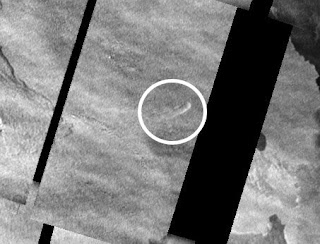 While processing the 24ISAMSKGI01 mosaic, presented in the previous post, I noticed an interesting features between Euxine Mons, a large mountain aligned North to South along the left side of the mosaic, and Amirani, a large lava flow just to the east. It appears to be a rounded trough leading away from the mountain (the sun is to the lower left) and toward the lava flow (or the other way around. A collapsed lava tube, perhaps, or a simple thermally eroded lava channel (keep in mind that this thing is 5 km wide). Still rather interesting.
While processing the 24ISAMSKGI01 mosaic, presented in the previous post, I noticed an interesting features between Euxine Mons, a large mountain aligned North to South along the left side of the mosaic, and Amirani, a large lava flow just to the east. It appears to be a rounded trough leading away from the mountain (the sun is to the lower left) and toward the lava flow (or the other way around. A collapsed lava tube, perhaps, or a simple thermally eroded lava channel (keep in mind that this thing is 5 km wide). Still rather interesting.
Amirani-Skythia-Gish Bar mosaic from I24
 Just finished up with this mosaic from Galileo's I24 flyby, 24ISAMSKGI01. This mosaic was released as PIA02526, a combination of high resolution clear filter data from this mosaic and lower resolution false-color from C21.
Just finished up with this mosaic from Galileo's I24 flyby, 24ISAMSKGI01. This mosaic was released as PIA02526, a combination of high resolution clear filter data from this mosaic and lower resolution false-color from C21.A lot of interesting geologic features can be seen in this mosaic, including several mountains, volcanic depressions, and lava flows. The name sake for this website, Gish Bar Patera and Gish Bar Mons, can be see on the right side of the mosaic. Io's most powerful lava flow field, Amirani, can be seen just to the right of the large gap in the mosaic. Monan Patera, Monan Mons, Skythia Mons, and Ah Peku Patera can be seen between Gish Bar and Amirani.
One more mosaic left to go for I24...
Link: Galileo I24 Images [pirlwww.lpl.arizona.edu]
Friday, March 28, 2008
More Playing with Celestia
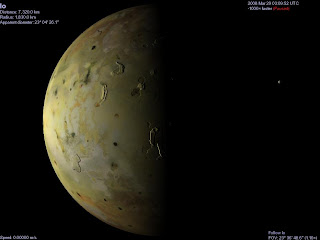 For the last few days, I've been having a lot of fun playing around with Celestia, an open-source 3D space visualization program. I've gotten the Jupiter and Saturn systems working just fine with NAIF spice kernels, got all the moons rotating correctly, and so on. Now I decided to play around with making a bump map for Io. You can see the state of this bump map at left, implemented in Celestia. I got most of the paterae in this area looking about how they should. The mountains take a little more time and require a lot of hand editing. I'm not quite satisified with the blocky appearance of the mountains, may have to try some smoothing.
For the last few days, I've been having a lot of fun playing around with Celestia, an open-source 3D space visualization program. I've gotten the Jupiter and Saturn systems working just fine with NAIF spice kernels, got all the moons rotating correctly, and so on. Now I decided to play around with making a bump map for Io. You can see the state of this bump map at left, implemented in Celestia. I got most of the paterae in this area looking about how they should. The mountains take a little more time and require a lot of hand editing. I'm not quite satisified with the blocky appearance of the mountains, may have to try some smoothing.I am also a little concerned by the way it shows mountains and other topography. Mountains are visible way to far around the dark side of the terminator (these things aren't that tall). They are also way to visible at low phase angles. But at phase angles like that above, I am pretty happy with the results.
Thursday, March 27, 2008
Jupiter System in Celestia
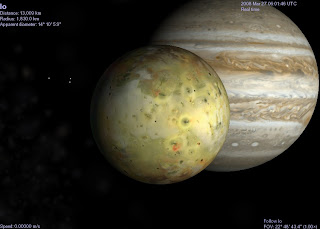 Sorry for the lack of updates in the last few days. I have been hard at work correcting some issues I've been having with Celestia both with my Saturn/Cassini plugin (which I need for work to create the graphics in the CICLOPS Looking Ahead articles) and my Jupiter/Galileo plugin. The issue stemmed from attempting to update these plugins to support new features in the bleeding edge version of the 3D Space visualization program. After several days of wanting to kill my computer (must...get...more...RAM) and a lot of help from Chris Laurel, one of Celestia's developers, I think I got everything sorted out, at least with the Jupiter/Galileo plugin.
Sorry for the lack of updates in the last few days. I have been hard at work correcting some issues I've been having with Celestia both with my Saturn/Cassini plugin (which I need for work to create the graphics in the CICLOPS Looking Ahead articles) and my Jupiter/Galileo plugin. The issue stemmed from attempting to update these plugins to support new features in the bleeding edge version of the 3D Space visualization program. After several days of wanting to kill my computer (must...get...more...RAM) and a lot of help from Chris Laurel, one of Celestia's developers, I think I got everything sorted out, at least with the Jupiter/Galileo plugin.All this plugin does is use NAIF Spice kernels to generate the position of Galileo, Jupiter, the Galilean Satellites, Amalthea, and Thebe for much improved precision. For example, using the default trajectory file for Galileo in Celestia, and the orbits used for Jupiter and Io, the close approach altitude for the I24 flyby was -1000 km (or thereabouts), obvious not correct. Using Spice Kernels, the C/A altitude is given as 610.5 km, less than a kilometer off the official value. This new update for Celestia allow me to have one version of Jupiter and its moons as opposed to having one Jupiter for before the period covered by the Spice kernels, one during, and one after.
This plugin also adds support for improved precision of each bodies rotation, which may vary due to libration.
The plugin is located at http://pirlwww.lpl.arizona.edu/~perry/Celestia/JupiterSpice.zip. Warning, that file is 163 MB in size.
Keep in mind that his requires the absolutely latest version of Celestia, Version 1.5. Not only that, but you need the latest SVN version, basically a nightly build. The previous link is for the Windows XP file (just copy the Celestia.exe file in that SVN zip file over the Celestia.exe where you installed Celestia). Keep in mind that this build may contain bugs so definitely use with caution. I haven't had an issues with it that I couldn't attribute to having a slow laptop.
Wednesday, March 26, 2008
Alan Stern and John Mather leaving NASA HQ
Two of the top scientists at the Science Mission Directorate (SMD) at NASA, Alan Stern and John Mather, resigned today to return to their own respective projects. No reason was given in their resignation letters, but speculation is ripe on the internets that it had something to do with the Mars program funding issues. The cost control issues seemed to have been a big part of the problem according to Keith Cowling over at NASA Watch. Alan Stern, who is the Associate Administrator of NASA, will be replaced by Ed Weiler when Stern leaves in a few weeks.
I am not familiar with John Mather, but Alan Stern, who is also the Principal Investigator of the New Horizons mission to Pluto, is well respected within the planetary science community and was considered a great asset at NASA headquarters. He will be sorely missed there as the Mars Program funding issues continues to heat up and the Outer Planets flagship mission will be selected later this year. His leadership was greatly valued.
I am not familiar with John Mather, but Alan Stern, who is also the Principal Investigator of the New Horizons mission to Pluto, is well respected within the planetary science community and was considered a great asset at NASA headquarters. He will be sorely missed there as the Mars Program funding issues continues to heat up and the Outer Planets flagship mission will be selected later this year. His leadership was greatly valued.
Monday, March 24, 2008
Jupiter-Ganymede-Io Animation
Mike Salway posted a cool animation of images he took of Jupiter, Ganymede, and Io over at the Cloudy Nights forum. These images were acquired on March 19. You can see a rotating Io, Io on the near-side of Jupiter orbiting off to the left, and Ganymede on the far-side of Jupiter orbiting off to the right. Note that you can see Ganymede emerging from an eclipse in the first frame.
Definitely worth checking out.
Link: Jupiter + GRS + Ganymede + Io + Animation [www.cloudynights.com]
Definitely worth checking out.
Link: Jupiter + GRS + Ganymede + Io + Animation [www.cloudynights.com]
OPAG Spring Meeting
 For those of you cooler than I going to the Outer Planets Assessment Group (OPAG) Spring Meeting in Boulder, Colorado next week, the preliminary agenda is now online. A good amount of the first day will be spent going over the two Joint Science Definition Team (JSDT) studies for the next flagship mission. For those not cool enough to be at the meeting, the presentations for the meeting should be online shortly after the meeting concludes on April 1.
For those of you cooler than I going to the Outer Planets Assessment Group (OPAG) Spring Meeting in Boulder, Colorado next week, the preliminary agenda is now online. A good amount of the first day will be spent going over the two Joint Science Definition Team (JSDT) studies for the next flagship mission. For those not cool enough to be at the meeting, the presentations for the meeting should be online shortly after the meeting concludes on April 1.Also on the OPAG website is the schedule of meetings for the Titan/Saturn and Europa/Jupiter JSDTs. So it looks like these studies are getting formulated pretty quickly. There is even a Titan/Saturn meeting here in Tucson, but it is not open to the community.
Besides, they wouldn't let me in the Jupiter/Europa meetings lest I go in there like Lyle Lanley trying to get them to spend their money to go to Io instead of Europa... "But Europa's Crust is still all cracked and broken! Sorry, Bob, the mob has spoken..."
Link: OPAG Preliminary Agenda [www.lpi.usra.edu]
S2O, polysulfuroxide and sulfur polymer on Io’s surface?
The other Io-related paper in the April 2008 issue of the journal Icarus is titled, "S2O, polysulfuroxide and sulfur polymer on Io’s surface?" and is written by Donia Baklouti, Bernard Schmitt, and Olivier Brissaud. Such research is important as the presence of condensed S2O is one explanation for the reddish deposits near some volcanoes.
In this paper, the authors performed laboratory experiments on S2O, a compound predicted to be among the gases expelled by volcanoes on Io but to date not observed. The authors synthesized the compound from gaseous SOCl2, then allowed the product to condense on a target in temperature and pressure conditions expected on Io. This experiment was preformed several times, with different temperature conditions applied to the sample, and with some having pure S2O in the initial gas and others with 2-10% S2O in a matrix of SO2, to match the expected gas composition at Io's volcanic vents. At various times, the authors then measured the visible and infrared spectra of the sample plate and compared their results to Galileo NIMS data of Io's surface.
In both gas samples, much of the S2O disproportionated into sulfur and SO2 before condensing on the sample plate. When the sample plate was at a temperature below 120K, the resulting condensation was often a mixture of SO2, sulfur, and a small amount of S2O. Above that temperature, SO2 can not condense or sublimates when the sample plate is heated above that temperature, leaving behind the sulfur and S2O. However, the S2O does not stick around for long as it polymerizes, forming longer chains of polysulfuroxides until the molecules lose more and more of their oxygen and yellow sulfur polymers are formed as the temperature is raised more. These results suggest that on Ionian surfaces below 120K, the appearance of S2O would be masked by the presence of SO2, forming whitish deposits, and sulfur polymers, while above that temperature S2O is converted into yellowish polysulfuroxides. These results further suggest that S2O can not explain the reddish deposits seen at some volcanoes. This further supports the idea that these deposits are formed from the condensation of S3 and S4 that is directly vented from Io's interior.
The authors compared their visible and infrared spectra measurements to Galileo NIMS spectra of Io. The authors found that many S2O absorption bands either occur on the wings of strong SO2 bands, which dominate Io's infrared spectrum, or are too shallow or would occur over too small a surface area to be observed by NIMS. The NIMS spectra is better explained by a combination of SO2, stable S8, and sulfur polymers.
Link: S2O, polysulfuroxide and sulfur polymer on Io’s surface? [dx.doi.org]
In this paper, the authors performed laboratory experiments on S2O, a compound predicted to be among the gases expelled by volcanoes on Io but to date not observed. The authors synthesized the compound from gaseous SOCl2, then allowed the product to condense on a target in temperature and pressure conditions expected on Io. This experiment was preformed several times, with different temperature conditions applied to the sample, and with some having pure S2O in the initial gas and others with 2-10% S2O in a matrix of SO2, to match the expected gas composition at Io's volcanic vents. At various times, the authors then measured the visible and infrared spectra of the sample plate and compared their results to Galileo NIMS data of Io's surface.
In both gas samples, much of the S2O disproportionated into sulfur and SO2 before condensing on the sample plate. When the sample plate was at a temperature below 120K, the resulting condensation was often a mixture of SO2, sulfur, and a small amount of S2O. Above that temperature, SO2 can not condense or sublimates when the sample plate is heated above that temperature, leaving behind the sulfur and S2O. However, the S2O does not stick around for long as it polymerizes, forming longer chains of polysulfuroxides until the molecules lose more and more of their oxygen and yellow sulfur polymers are formed as the temperature is raised more. These results suggest that on Ionian surfaces below 120K, the appearance of S2O would be masked by the presence of SO2, forming whitish deposits, and sulfur polymers, while above that temperature S2O is converted into yellowish polysulfuroxides. These results further suggest that S2O can not explain the reddish deposits seen at some volcanoes. This further supports the idea that these deposits are formed from the condensation of S3 and S4 that is directly vented from Io's interior.
The authors compared their visible and infrared spectra measurements to Galileo NIMS spectra of Io. The authors found that many S2O absorption bands either occur on the wings of strong SO2 bands, which dominate Io's infrared spectrum, or are too shallow or would occur over too small a surface area to be observed by NIMS. The NIMS spectra is better explained by a combination of SO2, stable S8, and sulfur polymers.
Link: S2O, polysulfuroxide and sulfur polymer on Io’s surface? [dx.doi.org]
Sunday, March 23, 2008
Transfer of mass from Io to Europa and beyond due to cometary impacts
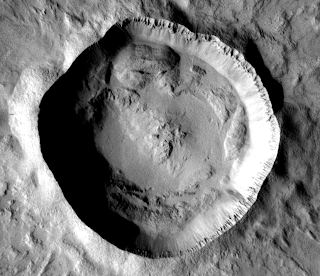 Yesterday I posted that the new issue of the journal Icarus is now online. Two papers in the issue are directly related to Io. The first is titled, "Transfer of mass from Io to Europa and beyond due to cometary impacts," by José Luis Alvarellos, Kevin J. Zahnle, Anthony R. Dobrovolskis and Patrick Hamill. In this paper, the authors describe their modeling of ejecta from impacts onto the surface of Io, determining where that ejecta eventually end up in the Jovian system, and calculating how much mass is transferred from Io to the other major satellites in the system.
Yesterday I posted that the new issue of the journal Icarus is now online. Two papers in the issue are directly related to Io. The first is titled, "Transfer of mass from Io to Europa and beyond due to cometary impacts," by José Luis Alvarellos, Kevin J. Zahnle, Anthony R. Dobrovolskis and Patrick Hamill. In this paper, the authors describe their modeling of ejecta from impacts onto the surface of Io, determining where that ejecta eventually end up in the Jovian system, and calculating how much mass is transferred from Io to the other major satellites in the system.They modeled the ejection process two different ways. First, they assumed the surface of Io is a regolith and an impact will fling pre-existing blocks or rubble out from the crater. Second, they used a model by Jay Melosh et al. (1986), where the impact ejects chunks known as spalls out from a more competent or hard rock target. Based on what is known of Io's surface, where volcanic resurfacing occurs at a faster rate than impact gardening, the authors state that the latter model is likely more applicable.
The authors simulated impacts at the apex (center of the leading hemisphere), the antapex (the center of the trailing hemisphere), the sub-jovian point, the anti-jovian point, and the south pole. From the two models described above, the authors were able to calculate the velocities of particles generated by the impact as well as how much ejecta is generated by the impact of a generic 1.5 km wide Jupiter-family comet. Finally, 600 test particles with velocities fast enough to escape Io's Hill Sphere were injected into a model of the Jovian system to see where these particles would end up after an integration of 10,000 years.
The authors determined that the vast majority of the ejecta would wind up reimpacting Io, 93% in the rubble model, 86% in the spall model. This is expected since the particles start out in Io-crossing orbits. Their simulations found that between 5% ("Rubble" model) and 9% ("Spall" model) of the test particles end up impacting Europa, typically in a few decades to a couple of centuries. In the spall model, 4.6% of the test particles impacted Ganymede and less than one percent impacted Callisto. Only a handful in that same model ended up either impact Jupiter or one of the small inner satellites, entered heliocentric space, or survived the 10,000 year simulation. Typically, more ejecta reimpacted Io in the rubble model (where initial velocities are less so they start out in less eccentric orbits) than in the spall model, where their higher initial velocities put them in orbits that crossed that of the other Galileans.
Based on the percentage of material transferred from Io to one of the other satellites, estimates of the amount of ejecta per impact (typically 3x the mass of the impactor), and the impact rate on Io, the authors estimated the amount of mass transferred from Io to one of the other Galileans per million years. They estimate that approximately 3.1×1014 g and 1.6×1014 g are transferred to Europa and Ganymede via impact ejecta every million years, making Io a significant source of minerals and nutrients to the surfaces of those moons. That's in addition to the mass transferred via sputtering.
Link: Transfer of mass from Io to Europa and beyond due to cometary impacts [dx.doi.org]
Three More Mosaics from the I24 Flyby
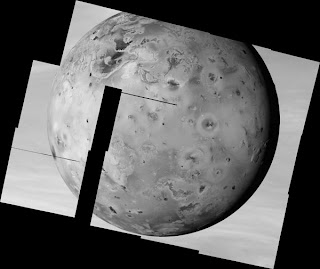 Today I got around to working on three more mosaics from Galileo I24 flyby. Like many of the mosaics from this encounter, none of these were released as complete mosaics by the Galileo project. These newly processed mosaics include: 24ISPROMTH02, a two-frame mosaic over Prometheus; 24ISTERMAP01, a six-frame mosaic covering terrain along the terminator; and 24ISSTEREO01 (left), a 12-frame nearly full-disk mosaic. With these done, I have two more observations to finish up with. I hope to have those done tomorrow or Monday.
Today I got around to working on three more mosaics from Galileo I24 flyby. Like many of the mosaics from this encounter, none of these were released as complete mosaics by the Galileo project. These newly processed mosaics include: 24ISPROMTH02, a two-frame mosaic over Prometheus; 24ISTERMAP01, a six-frame mosaic covering terrain along the terminator; and 24ISSTEREO01 (left), a 12-frame nearly full-disk mosaic. With these done, I have two more observations to finish up with. I hope to have those done tomorrow or Monday.24ISPROMTH02 covers the entire Prometheus flow field as well as Prometheus Patera, a volcanic depression at the northeastern end of the flow field. The images in this observation suffer from more gradient issues and other problems than most other images, but some details can be seen in the western part of the flow field and in the low mesa to the east.
24ISTERMAP01 is a six-frame north-south strip of images along 90° West Longitude near the terminator. This mosaic covers Hi'iaka Montes near the top of mosaic, as the sun sets on those mountains, the eastern parts of Itzamna Patera, and all the way south to Ekhi Patera. Again, the quality of the reconstructed summed images is not as good as some of the earlier observations, but topography at the margins of the paterae and lineaments in this region is visible as well as hints at some of the bright flows seen in earlier views of this region. Keep in mind that in addition to being near the terminator (thus accentuating topography rather than albedo features), these images are also near the limb, so the features here are foreshortened. Ekhi Patera is actually pretty close to circular in shape. The pixel scale here is 540 m/pixel.
24ISSTEREO01 is a 12-frame mosaic covering much of anti-Jovian hemisphere of Io at 1.45 km/pixel, with Jupiter providing a nice background. A smaller version of the mosaic can be seen at the top of this post. Unlike the other mosaics from the I24 flyby, these images were acquired in full-frame mode. Images acquired in that mode did not suffer from the scrambling inflicted on the summation mode images during I24. This mosaic was designed as part of a stereo pair along with a similar mosaic acquired during C21 in July 1999. The relatively blandness of much of the terrain outside Io's mountains and volcanoes, plus the unusual phase functions of many of its surface materials complicate the develop of Digital Elevation Models from these two data sets.
24ISSTEREO01 covers much of the same terrain seen in the full-disk color mosaic from C21, but Io is rotated about 40 degrees to the west, allowing for terrain between 220° and 260° West Longitude to be become visible. This includes prominent volcanoes such as Pele (near lower left), Pillan (to the north east of Pele), and Isum (near upper left). Also the higher phase angle makes it easier to spot topography, particularly along the terminator near 110° West. Mountains such as Gish Bar Mons, Egypt Mons, and Boosaule Montes can also be seen along the limb against the disk of Jupiter. The mitten-shaped plateau at right near the terminator is named Capaneus Mensa.
Anyways, so I have 2 more to go.
Link: Galileo I24 Images [pirlwww.lpl.arizona.edu]
Highlights o' the Last Week
This week was surprisingly busy. Flagship Mission news. More images processed. Kiluaea fun. Oh My!
- As reported today, the results of a peer review of the NASA Outer Planets Flagship mission studies were posted online with Europa being the big winner and Enceladus being cut from consideration. The next round of studies will include ESA as partner for both a Titan mission concept and a combined Europa/Jupiter System mission concept.
- Kiluaea experienced its first explosive eruption this week after a solfatara was observed in the Halema`uma`u crater atop the volcano that has been active for 25 years.
- Arthur C. Clarke, author of 2001: A Space Odyssey and Rendezvous with Rama, died this week at the age of 90.
- Several papers were published this week, including one on the Io footprint auroral glows on Jupiter.
- I started work on processing some of the scrambled images from I24, putting them together into mosaics that really have gotten wide circulation.
- Moses Milazzo had a party.
Saturday, March 22, 2008
More on LAPLACE/Europa Explorer
As reported this morning, NASA and ESA have agreed to combine some of their pending Flagship-class mission studies for the next phase of concept studies. For the Jupiter System, this will see the combination of NASA's Europa Explorer and ESA's LAPLACE/Europa-Jupiter System Mission. According to the ESA website, the LAPLACE concept, developed last year for their Cosmic Visions: 2015-2025 strategic roadmap, was designed to include three separate spacecraft: a Europa Orbiter (likely now NASA's Europa Explorer), a Jupiter Magnetospheric Orbiter (supplied by JAXA, Japan's space agency), and a Jupiter Planetary Orbiter (now to be supplied by ESA). This international collaboration follows ESA's original plan for the LAPLACE mission concept.
It should be noted that the Jupiter Planetary Orbiter (JPO), which will perform most of the Io remote sensing, will be cost capped at 1 Billion Dollars, less than was expected when the Jupiter System Observer concept was developed. Some likely consequences of this cut include leaving JPO in Jupiter orbit rather than going into orbit around Ganymede, and the shrinking of the main camera system. Also don't forget that ESA will be trying to perform this mission with less money than will be spent on Juno, so again, one has to wonder what ESA could do on this mission (unless, as Van Kane pointed out on UMSF last year, someone else provides the launch vehicle...)
So what Io science would be preformed by ESA's Jupiter Planetary Orbiter (as originally proposed) versus NASA's Jupiter System Observer. Not much info is available on a baseline trajectory for JPO. According to an article in Experimental Astronomy, no Io flybys are specifically mentioned, though it doesn't say that NO Io flybys will be performed, just that it will mostly do Europa, Ganymede, and Callisto flybys. The article does suggest that JPO would map Io's surface with a resolution of at least 500 m/pixel.
Selection of either the Jupiter/Europa mission or the Titan/TandEM mission will take place in October/November 2008 with a new start for the approved mission next year.
Link: Laplace mission summary [sci.esa.int]
It should be noted that the Jupiter Planetary Orbiter (JPO), which will perform most of the Io remote sensing, will be cost capped at 1 Billion Dollars, less than was expected when the Jupiter System Observer concept was developed. Some likely consequences of this cut include leaving JPO in Jupiter orbit rather than going into orbit around Ganymede, and the shrinking of the main camera system. Also don't forget that ESA will be trying to perform this mission with less money than will be spent on Juno, so again, one has to wonder what ESA could do on this mission (unless, as Van Kane pointed out on UMSF last year, someone else provides the launch vehicle...)
So what Io science would be preformed by ESA's Jupiter Planetary Orbiter (as originally proposed) versus NASA's Jupiter System Observer. Not much info is available on a baseline trajectory for JPO. According to an article in Experimental Astronomy, no Io flybys are specifically mentioned, though it doesn't say that NO Io flybys will be performed, just that it will mostly do Europa, Ganymede, and Callisto flybys. The article does suggest that JPO would map Io's surface with a resolution of at least 500 m/pixel.
Selection of either the Jupiter/Europa mission or the Titan/TandEM mission will take place in October/November 2008 with a new start for the approved mission next year.
Link: Laplace mission summary [sci.esa.int]
Icarus April 2008 Issue
The April issue of the prominent Planetary Science journal Icarus is now online for subscribers. Among the articles in this issue are two that are directly related to Io. The first, by José Luis Alvarellos, Kevin J. Zahnle, Anthony R. Dobrovolskis and Patrick Hamill, is titled "Transfer of mass from Io to Europa and beyond due to cometary impacts." In that paper, the authors presents the results of modeling ejecta from impacts onto the surface of Io and where that ejecta eventually end up. The second paper, by Donia Baklouti, Bernard Schmitt and Olivier Brissaud, is titled "S2O, polysulfuroxide and sulfur polymer on Io's surface?" In that paper, the authors discuss laboratory spectral measurements of S2O and other polysulfuroxide and experiments to see if condensates from these compounds are stable on Io's surface.
I will try to read through these papers this weekend and give a more thorough review of them here tomorrow.
Link: Science Direct - Icarus, Volume 194, Issue 2, Pages 399-858 (April 2008) [www.sciencedirect.com]
I will try to read through these papers this weekend and give a more thorough review of them here tomorrow.
Link: Science Direct - Icarus, Volume 194, Issue 2, Pages 399-858 (April 2008) [www.sciencedirect.com]
Evaluating the Flagship Concept Studies
The Outer Planets Assessment Group (OPAG), a community forum within NASA designed to help focus outer solar system exploration and to ensure that NASA mission decisions for the outer solar system have community input, released the results of a peer review of the Outer Solar System Flagship concept studies conducted and released last year. The peer review resulted in the downselection from four mission down to three. It had previously been known that the Enceladus mission concept was not selected for further study, but the document provides the rationale behind that rejection. Apparently, it was felt that the concepts developed did not adequately address the primary science goal of an Enceladus mission: to determine the biological potential of the south polar region. The other three missions, the Europa Explorer, the Jupiter System Observer, and the Titan Explorer, were given more favorable reviews with the Europa mission receive the best review.
For those who haven't seen them, there are pretty extensive PDFs covering each flagship mission concept on OPAG website. Io science is best dealt with by the Jupiter System Observer with four targeted flybys in the baseline trajectory. The baseline JSO mission also provides for repeated observations during the Jovian orbital tour as well as during the Ganymede orbit segment, where a top resolution of 775 m/pixel would be possible with the high-resolution camera. The Europa Explorer also includes a monitoring program (only before the Europa orbit segment of the mission), but EE as baselined never comes closer than 267,000 km to Io, providing images with a resolution of at best 2.67 km/pixel.
The other big news in the Downselection document is that NASA will be cooperating with ESA for the next phase mission concept studies. For this purpose, the Jupiter Science Observer and Europa Explorer missions have been combined into a single mission with two spacecraft (NASA providing Europa Explorer and ESA providing Jupiter System Observer). The Titan mission concept has been split between NASA and ESA with NASA proving the Titan Orbiter and ESA providing some type of in situ probe (either a lander or a balloon). Not sure what to make of this last bit of news. This might be good news since this could mean that both Europa Explorer AND Jupiter System Observer could fly as two component of a single, international mission, rather than only one being selected. With Europa Explorer getting favorable reviews and the favorite (at least IMO) to be selected, this could be good news.
Link: Downselection Results for 2007 Outer Planet Flagship Studies [www.lpi.usra.edu]
For those who haven't seen them, there are pretty extensive PDFs covering each flagship mission concept on OPAG website. Io science is best dealt with by the Jupiter System Observer with four targeted flybys in the baseline trajectory. The baseline JSO mission also provides for repeated observations during the Jovian orbital tour as well as during the Ganymede orbit segment, where a top resolution of 775 m/pixel would be possible with the high-resolution camera. The Europa Explorer also includes a monitoring program (only before the Europa orbit segment of the mission), but EE as baselined never comes closer than 267,000 km to Io, providing images with a resolution of at best 2.67 km/pixel.
The other big news in the Downselection document is that NASA will be cooperating with ESA for the next phase mission concept studies. For this purpose, the Jupiter Science Observer and Europa Explorer missions have been combined into a single mission with two spacecraft (NASA providing Europa Explorer and ESA providing Jupiter System Observer). The Titan mission concept has been split between NASA and ESA with NASA proving the Titan Orbiter and ESA providing some type of in situ probe (either a lander or a balloon). Not sure what to make of this last bit of news. This might be good news since this could mean that both Europa Explorer AND Jupiter System Observer could fly as two component of a single, international mission, rather than only one being selected. With Europa Explorer getting favorable reviews and the favorite (at least IMO) to be selected, this could be good news.
Link: Downselection Results for 2007 Outer Planet Flagship Studies [www.lpi.usra.edu]
Friday, March 21, 2008
Three More Mosaics from I24
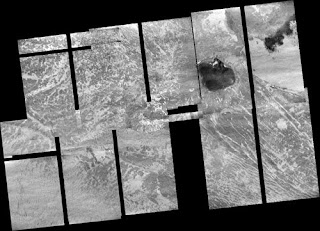 I finished up three more mosaics this evening from 1999's I24 flyby: 24ISPROMTH01, 24ISTOHIL_01, and 24ISDORIAN01. PROMTH01 covers the lava flow at Prometheus, while TOHIL_01 and DORIAN01 cover the mountains Tohil Mons and Dorian Montes, respectively.
I finished up three more mosaics this evening from 1999's I24 flyby: 24ISPROMTH01, 24ISTOHIL_01, and 24ISDORIAN01. PROMTH01 covers the lava flow at Prometheus, while TOHIL_01 and DORIAN01 cover the mountains Tohil Mons and Dorian Montes, respectively.A quick note on these images: these are the full-size mosaics. The original images were taken in 2x2 summation mode, which became corrupted before the I24 flyby. So the original raw images were 400x400 pixels in size (as opposed to 800x800 pixels for the normal mode images). As part of the unscrambling process, these images were doubled in size, to 800x800. The final unscrambled images submitted to the PDS were in that doubled size. During the course of my processing of these mosaics, I resampled each image back down to their original 400x400 size, whereas most of the released mosaics from the Galileo project left the images in that doubled form. I think by resizing the images back down to the size they were taken in, the quality of the final product is improved. So for example, you can clearly see the difference in the Pillan mosaic mentioned in the previous post between the smeared images (taken with 21-ms exposure times) and the crisper images (taken with 12-ms exposure times). I don't think this difference is as apparent in the expanded images originally released.
Okay, now on to the mosaics I've posted tonight. The first is 24ISPROMTH01. This mosaic covers the southern part of the Prometheus flow field and the surrounding bright terrain. The flow as crenulated margins as lava flowed around hillocks that cover the surrounding terrain before they cover them. The flow field itself is covered in numerous darker patches that represent new lava flows that hadn't yet been covered by brighter volatiles. It is rather interesting to compare the dark patches to those that show up in four months later. Many of the darker patches seen in I24 had faded while new dark flows showed up. These outbreaks are thought to be created when tubes channel lava from the main vent along a fissure at the eastern end of the flow field (seen between the last and second-to-last frame in 24ISPROMTH01) westward where the lava then emerge as sheet flows. Similar behavior was recently seen at the flows coming from Kiluaea (just imagine that channel is covered).
The next mosaic is 24ISTOHIL_01. This mosaic covers Tohil Mons, a 5.4 km tall mountain on Io's anti-Jovian hemisphere, and two volcanoes, Radagast Patera and Tohil Patera. Both volcanoes are in the upper right frame. Radagast is the dark, mitten-shaped depression; Tohil Patera pretty much covers the whole right side of the upper right frame. Yes, trust me, there is a mountain there. Images acquired during the I32 flyby show the area in low-sun conditions if you don't believe me. If you looks closely, you will note a small surface change within Radagast Patera, where a small, fan-shaped lava flow formed between I24 and I32. Also, comparisons between the two observations can give you an idea of what albedo patterns seen in I24 correspond to which topographic feature in I32.
Finally, there is 24ISDORIAN01. Like the Tohil observation, this shows a tall mountain (Dorian Montes) at high-sun conditions, making the mountain nearly invisible. You can still make out some topographic features that are marked by albedo markings as well. At least two volcanoes are visible in this mosaic: a pair of lava flows associated with Marduk Fluctus in the first frame and Haokah Patera in the third.
Still got plenty more to go. Stay tuned.
Link: Galileo I24 images [pirlwww.lpl.arizona.edu]
Thursday, March 20, 2008
Mosaics from I24 Reconstructed Images
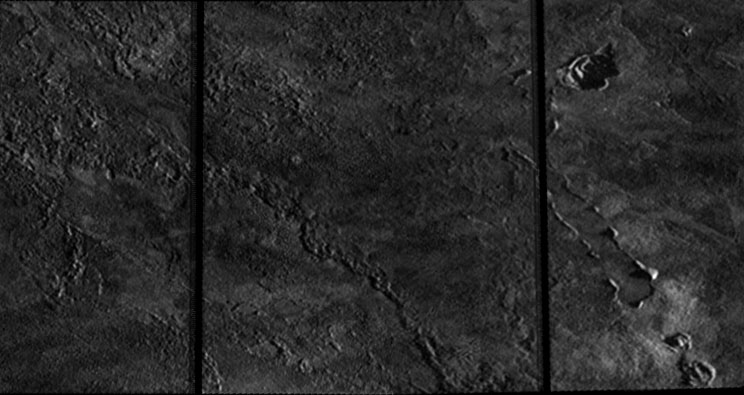 I've started processing some of the mosaics from the Galileo I24 flyby that took place on October 11, 1999. Most of the images acquired during this flyby were taken in 2x2 summation mode, so the images had half the resolution of normal mode images. Unfortunately, an error in the camera, that began on the previous orbit, caused these images to become scrambled. Luckily, an algorithm was developed that reconstructed the scrambled images.
I've started processing some of the mosaics from the Galileo I24 flyby that took place on October 11, 1999. Most of the images acquired during this flyby were taken in 2x2 summation mode, so the images had half the resolution of normal mode images. Unfortunately, an error in the camera, that began on the previous orbit, caused these images to become scrambled. Luckily, an algorithm was developed that reconstructed the scrambled images.So tonight I started working through some of these for my images page, particularly the 24ISPILLAN01, 24ISCOLCHS01, and 24ISZAMAMA01 mosaics. Ordinarily, I would initially process these images in ISIS before piecing the mosaics together in Photoshop. Unfortunately, these reconstructed images aren't fully in PDS-compatible format so ISIS can work with them beyond the initial conversion to ISIS. So I can't reproject them, which would make it easier to piece them together. So everything was done in Photoshop, piecing them together and adjusting each image so that they would fit together. I think the results turned out pretty well.
24ISPILLAN01 covers a lava flow that formed during the summer of 1997 north of Pillan Patera on Io's trailing hemisphere. The flow can be seen as the darker material on the western two-thirds of the mosaic. According to Williams et al. 2001, the lava flow appears to have been emplaced as a turbulent sheet flow, with few apparent channels. Several pits are also seen that maybe rootless cones, formed from the interaction between the hot, flowing lava and the sulfurous frost beneath. On the eastern third of the mosaic, the terrain that existed before eruption can be seen. It appears hummocky with at least one apparent flow margin, suggestive of a prior eruption at this location. It isn't certain if the hummocky nature of the surface existed before the 1997 eruption, or if it is related to pyroclastic processes that occurred during that event.
24ISCOLCHS01 is a high-resolution mosaic covering Ot Mons in the central part of Colchis Regio. The mountain is covered in numerous hummocks, similar to the surface of the northern component of Hi'iaka Montes, and is likely related to the degradation of the mountain.
24ISZAMAMA01 covers the southern portion of the Zamama lava flow (a major volcanic center during the 1990s) and the surrounding terrain. The Zamama vent is just to the upper left of the mosaic and is surrounded by lava flows radiating out from it (see this image from the 24ISZAMAMA02 observation for context). The toes of some of the flows that radiate south can be seen at the far left hand side of the mosaic. To the east of those are bright, incised channels that might be related to sulfur volcanism. Portions of the main Zamama lava flow can be seen through the rest of the mosaic. This flow has a relatively bland surface with crenulated margins.
There are plenty more mosaics to work on but it is getting quite late here. Hope you all enjoy these.
Link: Galileo I24 images [pirlwww.lpl.arizona.edu]
Wednesday, March 19, 2008
Moses Milazzo's Going Away Party
 The denizens of the Planetary Image Research Laboratory (PIRL) had a going away potluck lunch today for Moses Milazzo and Chris Okubo. Both are working on the HiRISE project for PIRL's director (and my boss), Alfred McEwen. Moses Milazzo has been at PIRL since 1997. At one point, he worked pretty heavily on Galileo image processing, particularly Galileo cartographic work and mosaics of Io. A couple of the more prominent mosaics that he worked on that were released during the Galileo mission include the C21 color mosaic (left) and merged low-resolution color-high resolution greyscale data from the Io flybys (like this one of the Culann-Tohil region).
The denizens of the Planetary Image Research Laboratory (PIRL) had a going away potluck lunch today for Moses Milazzo and Chris Okubo. Both are working on the HiRISE project for PIRL's director (and my boss), Alfred McEwen. Moses Milazzo has been at PIRL since 1997. At one point, he worked pretty heavily on Galileo image processing, particularly Galileo cartographic work and mosaics of Io. A couple of the more prominent mosaics that he worked on that were released during the Galileo mission include the C21 color mosaic (left) and merged low-resolution color-high resolution greyscale data from the Io flybys (like this one of the Culann-Tohil region).Moses will now be moving on to the USGS Astrogeology department in Flagstaff, Arizona. Good luck to him there. This also makes me the last of the "Io-era" holdouts.
Tuesday, March 18, 2008
Solfataras at Kilauea
 The Honolulu Star-Bulletin reported today on a brand new gas vent at the Halema`uma`u crater at the Kilauea volcano on the island of Hawaii. This gas vent, also known as a solfatara or fumerole, has emitted a large amount of sulfur dioxide, sulfur trioxide, and water vapor over the last few days to the point where health warnings and closures have been issued for the area around Kilauea. Also in the last few days, dull red glowing material has been visible near these vents. The temperature of this material is only 772 K, which might be indicative of molten sulfur.
The Honolulu Star-Bulletin reported today on a brand new gas vent at the Halema`uma`u crater at the Kilauea volcano on the island of Hawaii. This gas vent, also known as a solfatara or fumerole, has emitted a large amount of sulfur dioxide, sulfur trioxide, and water vapor over the last few days to the point where health warnings and closures have been issued for the area around Kilauea. Also in the last few days, dull red glowing material has been visible near these vents. The temperature of this material is only 772 K, which might be indicative of molten sulfur.Solfataras might be a good terrestrial analog for Io's Prometheus-type plumes. These plumes are thought to be formed when silicate lava interacts with sulfur dioxide frost on the surface.
Link: Glowing sulfur stumps brains at volcano site [starbulletin.com]
UV Io footprint leading spot
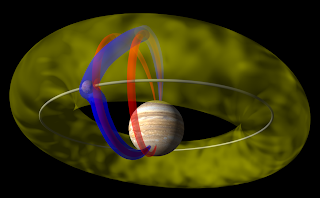 I got a chance to read the Io footprint paper that was published on Saturday and made the space news rounds yesterday. The article is titled, "UV Io footprint leading spot: A key feature for understanding the UV Io footprint multiplicity?", and was published in the journal Geophysical Research Letters (Geophys. Res. Lett. or GRL) by Bertrand Bonfond et al.
I got a chance to read the Io footprint paper that was published on Saturday and made the space news rounds yesterday. The article is titled, "UV Io footprint leading spot: A key feature for understanding the UV Io footprint multiplicity?", and was published in the journal Geophysical Research Letters (Geophys. Res. Lett. or GRL) by Bertrand Bonfond et al.The Io footprint is an auroral glow at Jupiter's north and south polar regions that is generated by infalling ions traveling along Alfvén waves between Io and Jupiter. This connection between Io and Jupiter is an Alfvén wing known as the Io Flux Tube. This connection is bent with respect to the magnetic field lines depending on Io's position in the plasma torus as Alfvén waves travel slower through dense plasma (like in the torus). So if Io's is at its furthest point in its orbit above the plasma torus (the torus is tilted with respect to Io's orbit by 7 deg., as is Jupiter's magnetosphere), the waves travel essentially along the magnetic field lines to the north polar Io footprint since it travels through less plasma, while they are significantly bent as they travel to the south polar footprint. Also, the auroral emission at the north polar footprint is brighter than in the south. The reverse is true if Io is at its furtherest point below the torus in its orbit.
The authors looked at observations of the Io footprint in the UV from the Hubble telescope acquired between 1997 and 2007. They noted several spots in addition to the main Io footprint. In most cases, they resolved fainter spots trailing the main bright spot, and in some cases, a faint spot leading the main spot. They found that when Io is at its highest point above the torus in its orbit, the spots trailing the Io footprint in the north were at their brightest and there was a spot leading the Io footprint in the south. They found the reverse when Io was at its farthest point below the plasma torus; there were multiple bright spots trailing the main footprint in the south, and a leading spot in the north.
They interpret this data to indicate that the leading spot is the result of a connection along magnetic field lines between the brighter Io footprint and the other spot near the other pole (remember the fainter spot also trails the brighter footprint because the Alfvén waves that make it have to travel through more plasma in the plasma torus). The secondary spots trailing the brighter Io footprint are created by a connection along magnetic field lines from the fainter Io footprint to the brighter one. Since the fainter one trails, the waves will impact Jupiter's upper atmosphere behind the brighter spot.
A pretty interesting paper with an elegant model. Since I am not a plasma physicist, I can evaluate the model to see whether it passes the non-sense test, but as a non-specialist, it seemed to make sense to me.
ADDED: I replaced the original image in this post with a cartoon schematic illustrating the various connections that create the Io footprint. The blue connections are the Alfvén wings between Io and Jupiter. The connection to the south pole basically follows the magnetic field lines between Io and Jupiter because it doesn't encounter much plasma (in the cartoon, Io is near its southernmost point in its orbit so most of the Io plasma torus is above it). The connection to the north is bent as the Alfvén waves are slowed by the plasma torus. The red connections are the magnetic field lines that connection the Io footprint in one pole to the other pole.
Link: UV Io footprint leading spot [www.agu.org]
Arthur C. Clarke Dead at Age 90
 The Associated Press is reporting that Arthur C. Clarke, author of such Sci-fi classics as 2001: A Space Odyssey and Rendezvous with Rama, died today at his home in Colombo, Sri Lanka at the age of 90.
The Associated Press is reporting that Arthur C. Clarke, author of such Sci-fi classics as 2001: A Space Odyssey and Rendezvous with Rama, died today at his home in Colombo, Sri Lanka at the age of 90.While in recent years he has been more known for his imaginative interpretations of Mars polar imagery, his vision of the future laid out in the 2001 series has certainly influenced my opinion on the possibilities of mankind and what we can do if we put our minds to it. More than anyone else, the ideas he presented provided an optimistic view of the future, unlike the dystopian visions presented in so many modern sci-fi films. Unlike Star Trek, though, his stories were consistent not only with harshness of space, but that even in the future, man's foibles won't magically disappear (or be covered up by technology). Yet, these failings need not lead us into some kind of apocalyptic scenario.
For a good representation of Io in fiction, check out Clarke's early 80s novel, "2010". The first novel in the series actually took place in the Saturn system and the other two novels, "2061" and "3001", took place after his detonation of Jupiter.
Link: Author Arthur C. Clarke dies [www.cnn.com]
Monday, March 17, 2008
Auroral Spot Leading Io Footprint on Jupiter
 A new paper just published in Geophysical Research Letters by B. Bonfond et al. has been making the rounds around various space websites today titled, "UV Io footprint leading spot: A key feature for understanding the UV Io footprint multiplicity?" I am not a space physics person so I usually wouldn't cover a paper like this here on this blog, but it isn't every day that Io makes the news.
A new paper just published in Geophysical Research Letters by B. Bonfond et al. has been making the rounds around various space websites today titled, "UV Io footprint leading spot: A key feature for understanding the UV Io footprint multiplicity?" I am not a space physics person so I usually wouldn't cover a paper like this here on this blog, but it isn't every day that Io makes the news.The best overview I have seen is by Phil Plait over at Bad Astronomy. Space Physics is not my specialty, so I think he explained what the authors found better than I can, but I am going to try anyway... Another good overview can be found at space.com.
The paper covers the Io footprint within Jupiter's aurorae. The "footprint" is a glow caused by charged particles, originating from Io, impacting Jupiter's upper atmosphere. You can see the footprint in the image above as the bright glow on the left. The footprint is not a single glow but has various structures, including a tail behind it and a fainter spot in front of it. It is the fainter "leading spot" that is the subject of this paper. This leading spot is the result of a connection in Jupiter's magnetic field between the Io footprint at Jupiter's northern and southern polar regions.
This news even made the Yahoo front page with the headline, "'Glowing spots' on Jupiter caused planet's volcanic moon." I know, they forgot the word 'by' between 'caused' and 'planet's', but still, I did a spit take when I saw that. Great, let's give the Electric Universe people something to foam about...
I haven't had a chance to peruse the paper yet. I'll take a look at it tomorrow, and report here if there is anything that Phil hasn't already mentioned.
Link: UV Io footprint leading spot [www.agu.org]
Io Transiting Across Jupiter
Several observers in Australia and The Philippines observed a transit of Io across the disk of Jupiter yesterday (Universal Time). The images some of these observers acquired are posted on the ALPO-Japan website. Anthony Wesley acquired an image just prior to the transit showing Io's shadow on Jupiter's cloud tops. Christopher Go acquired two images showing Io against the cloud tops of Jupiter. Io's reddish coloration is quite visible. Tomio Akutsu acquired similar images, though he also acquired images in other filter like in the UV, near-IR, and the 889 nm methane band. Io stands out quite well in those last two IR filters.
Link: Jupiter Image 2008/03/16(UT) [alpo-j.asahikawa-med.ac.jp]
Link: Jupiter Image 2008/03/16(UT) [alpo-j.asahikawa-med.ac.jp]
Saturday, March 15, 2008
Highlights o' the Week
It has been a busier week than usual thanks the Lunar and Planetary Sciences Conference, quite a few images added to my Galileo Io Images website, and some news on the New Frontiers 3 front.
- Seven presentations on Io were displayed at a poster session on Tuesday night in League City, Texas. Overviews of each abstract and other LPSC news are collected here.
- I finished a large mosaic from Galileo orbit I27 covering the Chaac-Camaxtli region of Io. Both clear-filter and one combined with lower-resolution C21 color data versions are available.
- Reprocessing of images from E11 revealed two eruptions columns for a Prometheus-type plume at Kanehekili that I don't recall having been mentioned before.
- The Space Sciences Board released their recommendations for the slate of missions for the next New Frontiers Announcement of Opportunity. One of the mission profiles recommended is an Io Observer. Such a mission would have to do its observations without RTGs as an energy source. This greatly limits the ability for an Io Observer to accomplish the scientific goals outlined by the SSB. This would make such a mission less attractive than the other mission profiles that can be accomplished just fine with solar power.
Galileo E15 Reprocessed Images
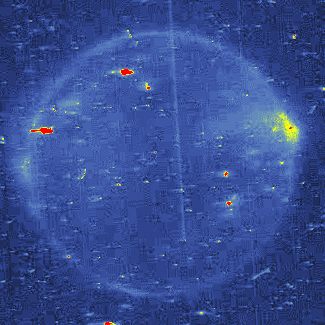 Between bouts of playing Guitar Hero III that I picked yesterday, I finished up reprocessing images from Galileo orbit E15. These images were acquired between May 30 and June 1, 1998. The highlight of this flyby were a series of images acquired during two eclipses on early on May 31 and late on June 1. These sequences included several clear filter observations and color sequences designed to examine hotspots at Io's volcanoes and auroral glows. I didn't have much success processing the color images but you can check out the best of them in the Planetary Photojournal. The best of the clear filter images can be seen in all its color-coded glory at left. The two brightest hotspots visible here are Camaxtli Patera (left) and an unnamed patera at 42° North, 92° West (upper left). A few other hotspots that are visible include Zal, Kanehekili, and Janus.
Between bouts of playing Guitar Hero III that I picked yesterday, I finished up reprocessing images from Galileo orbit E15. These images were acquired between May 30 and June 1, 1998. The highlight of this flyby were a series of images acquired during two eclipses on early on May 31 and late on June 1. These sequences included several clear filter observations and color sequences designed to examine hotspots at Io's volcanoes and auroral glows. I didn't have much success processing the color images but you can check out the best of them in the Planetary Photojournal. The best of the clear filter images can be seen in all its color-coded glory at left. The two brightest hotspots visible here are Camaxtli Patera (left) and an unnamed patera at 42° North, 92° West (upper left). A few other hotspots that are visible include Zal, Kanehekili, and Janus.Two sunlit sequences were returned from E15. The first, 15ISHIPHAS01, was taken 20 minutes prior to the eclipse image above. Some surface changes (mostly related to changes in the distribution in Sulfur dioxide) were noted around Kanehekili by Geissler et al. 2004 compared to images taken in November 1997. The other, 15ISKANEHI01, was taken shortly after the end of the second eclipse and shows the trailing hemisphere of Io at half-phase.
Link: Galileo E15 Images [pirlwww.lpl.arizona.edu]
Thursday, March 13, 2008
Galileo E11 Reprocessed Images
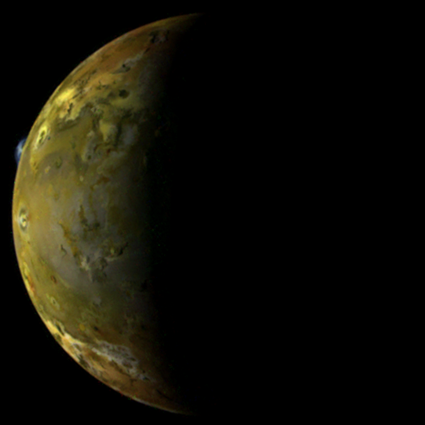 Yesterday, I posted on one of the images I had worked on from the Galileo's E11 orbit, that last of that spacecraft's primary mission. This evening, I finished processing the rest of the images (except for the eclipse images) from that orbit.
Yesterday, I posted on one of the images I had worked on from the Galileo's E11 orbit, that last of that spacecraft's primary mission. This evening, I finished processing the rest of the images (except for the eclipse images) from that orbit.These images were acquired on November 7-8, 1997 and for the most part show Io at high phase angles. These observations were designed to look at the state of Io's plume activity at the end of Galileo's primary mission. In these images, a total of five plumes were observed: Prometheus, Zamama, Marduk, Pillan, and Kanehekili. The Pillan and Kanehekili plumes were only observed twice by Galileo, while the other three were observed at various times throughout the Galileo mission.
The Kanehekili plume stood out to me while looking through these images. The plume is visible in the 11ISKANEHI01 observation. Enhancing the contrast of the VIOLET filter reveals something rather interesting about the Kanehekili plume: there are two eruption columns separated by about 70 km. This would suggest that there are two plumes at Kanehekili (or at least two plume sources within the flow field). Both were formed as different flow lobes from Kanehekili 1997 eruption overtook an area of sulfur dioxide frost and launched the frost skyward. Similar behavior was seen at the Masubi flow field last year by New Horizons, though the separation between plume sources was greater in the latter case. The Kanehekili plume was also observed in May 1997. Only one eruption column was seen at the time.
Link: Galileo E11 Images [pirlwww.lpl.arizona.edu]
Io Observer recommended, still won't happen
The Space Studies Board released their recommendations for the mission options for the next New Frontiers mission Announcement of Opportunity, due out in June. They recommended a wide-variety of missions highlighted in the Decadal Survey from a few years ago including: Lunar South Pole-Aiken Basin Sample Return, Venus In Situ Explorer, Comet Surface Sample Return, Network Science (a multi-lander mission to either Venus, Mercury, the Moon, or Mars), Trojan/Centaur Reconnaissance, Asteroid Rover/Sample Return, Ganymede Observer, and drum-roll please, an Io Observer. Nice to see that an Io Observer is still at least among the top eight missions for its class.
It, however, still won't happen this time around due to the restriction placed on the program by the lack of available plutonium for RTGs or nuclear-electric propulsion sytems (only enough currently for the Mars Science Laboratory, the next Discovery mission, and the next Flagship mission to the outer solar system). I do like the addition by the study group of "Innovative Mission Ideas", basically suggesting to NASA that the New Frontiers AO be as open as possible to all types of (preferably non-Mars) missions that fit within the cost cap.
The link to the report is below. Just click on "Read this book online, free." Thanks to Bruce Moomaw for the tip.
ADDED: I should note that Pamela over at Astronomy Cast Live posted on that blog that Jim Green, the Director of the Planetary Science Division at NASA, stated during a meeting either last night or tonight, that the New Frontiers AO will be open to all missions except to Earth and the Sun that fit within the budget and power source constraints. Preference will be given to those proposals that fit within those nine mission profiles mentioned above. Now, we just need to figure a way to do an Io Observer mission with solar panels (and not fry them in the process...).
ADDED: Quick correction. The SSB recommended a Trojan Asteroid/Centaur reconnaissance mission, not a sample return.
Link: Opening New Frontiers in Space: Choices for the Next New Frontiers Announcement of Opportunity [www.nap.edu]
It, however, still won't happen this time around due to the restriction placed on the program by the lack of available plutonium for RTGs or nuclear-electric propulsion sytems (only enough currently for the Mars Science Laboratory, the next Discovery mission, and the next Flagship mission to the outer solar system). I do like the addition by the study group of "Innovative Mission Ideas", basically suggesting to NASA that the New Frontiers AO be as open as possible to all types of (preferably non-Mars) missions that fit within the cost cap.
The link to the report is below. Just click on "Read this book online, free." Thanks to Bruce Moomaw for the tip.
ADDED: I should note that Pamela over at Astronomy Cast Live posted on that blog that Jim Green, the Director of the Planetary Science Division at NASA, stated during a meeting either last night or tonight, that the New Frontiers AO will be open to all missions except to Earth and the Sun that fit within the budget and power source constraints. Preference will be given to those proposals that fit within those nine mission profiles mentioned above. Now, we just need to figure a way to do an Io Observer mission with solar panels (and not fry them in the process...).
ADDED: Quick correction. The SSB recommended a Trojan Asteroid/Centaur reconnaissance mission, not a sample return.
Link: Opening New Frontiers in Space: Choices for the Next New Frontiers Announcement of Opportunity [www.nap.edu]
Wednesday, March 12, 2008
Io and Amalthea from Galileo Orbit E11
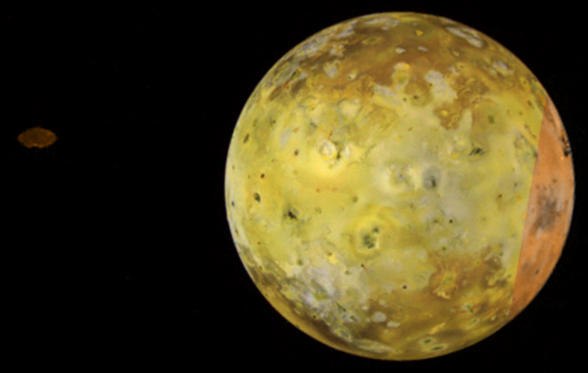 I was working a little bit on the Galileo E11 dataset this afternoon. I am switching over to work on Enceladus images now that data from today's Cassini encounter are hitting the ground. I thought I would share the one image I did get done with today. The image at left is from the 11ISLOWPHA01 observation and shows Io's sub-Jovian hemisphere in RED-GREEN-VIOLET color (with a little bit of "Voyager" color on the right edge where there is no GREEN filter data). The RED filter image also captured Amalthea, one of Jupiter's small inner satellites, as it passed through the field of view at the time.
I was working a little bit on the Galileo E11 dataset this afternoon. I am switching over to work on Enceladus images now that data from today's Cassini encounter are hitting the ground. I thought I would share the one image I did get done with today. The image at left is from the 11ISLOWPHA01 observation and shows Io's sub-Jovian hemisphere in RED-GREEN-VIOLET color (with a little bit of "Voyager" color on the right edge where there is no GREEN filter data). The RED filter image also captured Amalthea, one of Jupiter's small inner satellites, as it passed through the field of view at the time.Surface features can appear quite different on Io depending on the phase angle. This image was acquired when Galileo was almost directly between Io and the Sun, a low phase angle. The 11ISTOPO__01 observation, acquired seven hours later, shows much of this same area at a moderate phase angle. Some lava flows and plume deposits stand out more at moderate phase angles than at low phase angles.
Link: E11 Images [pirlwww.lpl.arizona.edu]
Little Bits 'O the Day - March 12, 2008
A few random items for today:
- On Monday, Anthony Wesley took a nice shot of Jupiter with Io on its far side. Obviously, don't expect any surface detail for Io, but still a nice shot.
- Cassini encounters Enceladus, a moon of Saturn that is one of only three moons that are geologically active (the other being Io and Neptune's moon Triton). The closest approach for this encounter is a scant 50 km above the nightside of the 500 km wide satellite. Images are expected mostly from before closest approach, with a best resolution of 200 m/pixel, of the cratered north polar region and sub-Saturn hemisphere. Enceladus enters a 2-hour long eclipse shortly after closest approach when Cassini will fly through the moon's south polar plume, analyzing the dust and gas within the plume (looking for, among other things, trace higher-order organics) and mapping the thermal emission coming from the south polar region, a very youthful area filled with with tectonic fractures, fissures, and ropy terrain. Images and other data from this encounter come down later tonight and early tomorrow morning, so it looks like it will be an early day for me as I work on processing the images that are returned.
- Thanks to Emily Lakdawalla and wanderingspace.net for the shout-outs on their blogs!
Sulfur dioxide and Sulfur in Tvashtar's Plume
 There is a nice blog post by Ted Stryk, guest blogging for the Planetary Society at the Lunar and Planetary Sciences Conference, on some of the presentations from last night's poster sessions and yesterday afternoon's lunar session. One of posters Ted highlights is the one by Kandis Lea Jessup and John Spencer titled, "Detailed Analysis of the Tvashtar Plume Spectral Behavior." I highlighted the abstract for this poster last week.
There is a nice blog post by Ted Stryk, guest blogging for the Planetary Society at the Lunar and Planetary Sciences Conference, on some of the presentations from last night's poster sessions and yesterday afternoon's lunar session. One of posters Ted highlights is the one by Kandis Lea Jessup and John Spencer titled, "Detailed Analysis of the Tvashtar Plume Spectral Behavior." I highlighted the abstract for this poster last week.Ted reports that the authors have determined that the S2 to SO2 ratio in the Tvashtar plume was between 0.01 and 0.02. In other words, in their measurements based on images taken by Hubble last February, the plume consisted of significantly more Sulfur dioxide than diatomic Sulfur. This value would seem to be in conflict with the presence of a red ring plume deposit, which is thought to be caused by the deposition of sulfur from Io's plumes. However, measurements of the Pele plume suggest that the Sulfur to Sulfur dioxide in these larger plumes can vary between 0.01 and 0.3, so the low ratio at Tvashtar may not be representative of the average.
Another consequence of the low S2/SO2 ratio is that the high optical depth seen in the Hubble WFPC2's F255W filter (an ultraviolet filter that senses gases in Io's plumes, rather than the dust seen in visible wavelength images like the LORRI images above) was not due to absorption by S2, but instead is due to SO2.
An interesting result. Definitely indicates that Tvashtar's plume was quite gas rich.
Tuesday, March 11, 2008
Galilean Satellites Poster Session Tonight
Checking up on the blog before after today's LPSC sessions? Don't forget to visit the Galilean Satellites poster session in the Athletic Center of the South Shore Harbor Resort and Conference Center. Yeah, you have to make the long trek all the way over from the hotel to the athletic center, but you'll be glad you did. Show the Io poster presenters some love by stopping by their posters.
If you are there, please feel free to share your thoughts. Trash the Europa map and praise the Io one. Have at it. ;) (Don't actually trash it, a lot of work was put into it, even if it is Europa)
If you are there, please feel free to share your thoughts. Trash the Europa map and praise the Io one. Have at it. ;) (Don't actually trash it, a lot of work was put into it, even if it is Europa)
LPSC 2008: Heat Flow from Dark Volcanic Fields
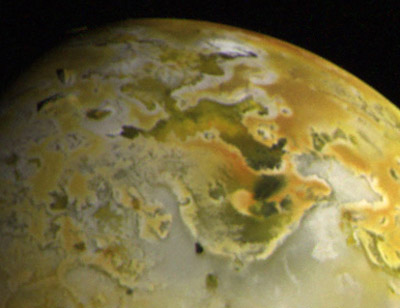 I've covered all the Io-related abstracts in tomorrow night's (wait, now tonight's) poster session covering the Galilean Satellites. Yeah, Io got lumped in with *shiver* Europa (in my mind, there are United Nations peace keepers between the Io and Europa poster boards), Ganymede (everyone's second favorite schizophrenic moon), and Callisto (thanks to the discovery of rings around Rhea, Callisto now possesses the sole title of most boring moon ever). So, if you are at LPSC, be sure to visit the poor Ionians as they will most likely shoved along the back wall like they were last year. Please, show them some love.
I've covered all the Io-related abstracts in tomorrow night's (wait, now tonight's) poster session covering the Galilean Satellites. Yeah, Io got lumped in with *shiver* Europa (in my mind, there are United Nations peace keepers between the Io and Europa poster boards), Ganymede (everyone's second favorite schizophrenic moon), and Callisto (thanks to the discovery of rings around Rhea, Callisto now possesses the sole title of most boring moon ever). So, if you are at LPSC, be sure to visit the poor Ionians as they will most likely shoved along the back wall like they were last year. Please, show them some love.Anyways, I am rambling on here. There is an additional Io-related abstract submitted to the LPSC conference, a print-only abstracted by Glenn Veeder, Dennis Matson, Ashley Davies, and Torrence Johnson titled, "Io: Heat Flow from Dark Volcanic Fields." The authors examined the distribution of dark flow fields on Io and examine their contribution to Io's high heat flow (the total amount of heat released in a given time period from the interior). As a print-only abstract, the results presented in this abstract will not be presented at a talk or a poster at LPSC.
The authors focused on dark flow fields, areas where lava has flowed across Io's flat(ish) plains, rather than those flows within the topographic confines of a patera. It is thought that these flows are compound pahoehoe silicate lava flows, built up by small outbreaks on top of older flows punctuated by period of high eruption rates that rapidly grow the lava (akin to flood basalts on Earth). They determined that dark flow fields are not distributed evenly across all longitudes with a peak near the center of the anti-Jovian hemisphere (in the abstract, the anti-Loki hemisphere). Flows seen near this peak include Prometheus, Zamama, Thor, Culann, Volund, and Mycenae Regio. This correlates well with a peak in the distribution of volcanic centers and paterae. The authors note that a correlation is not seen at the other peak in volcanic centers and paterae near 325° West, which includes Loki.
The authors then examined the contribution these lava flows make to Io's total heat flow. In the abstract, they focused on two prominent flow fields: Lei-Kung Fluctus (shown above, big flow field on Io's northern trailing hemisphere) and Amirani. Using NIMS and PPR data from Galileo, the authors calculated that that the two lava flows contribute 4.5x1011 W and 1.5x1012 W to Io's total heat flow, which is on the order of 1014 W. In total, the 24 flow fields the authors examined contribute approximately 10% to Io's total heat flow, equivalent to Loki Patera. It should be noted that the authors mapped about 3x105 km2 worth of dark flows. This is about 25% of the total amount of dark lava flows covering Io's surface according to the mapping done by Williams et al., so that 10% figure maybe an underestimate. I can't tell, but it also seems like they assumed an effective temperature (basically an average temperature for the entire flow field) to come up with their heat flow numbers for at least some of the fields they mapped.
An interesting abstract. I will be interested in seeing how their dark flow mapping compares to what Williams et al. has done (this also sounds like the kind of project that global geologic mapping is suited for), particularly since Williams et al. mapped a factor of 4 more dark flows material than Veeder et al. did.
Link: Io: Heat Flow from Dark Volcanic Fields [www.lpi.usra.edu]
Monday, March 10, 2008
New Template
I changed the Blogger template used for The Gish Bar Times. While the previous version looked a little more sleek than this one, I also thought it was a little difficult to see sidebar headings and links. They show up a lot easier now, though I still want to experiment with customizing the page. Not today but maybe sometime in the next week I will create a custom header graphic.
Comment away on what you think. And feel free to use the comment system and not just send me emails.
Comment away on what you think. And feel free to use the comment system and not just send me emails.
Not in Houston
For the last time, I am not in Houston. My current location is nearly 1,100 miles from the conference center (by car). So, I am not at LPSC this year. Don't blame me, blame LPSC being a week earlier this year (and not coinciding with the U of A's Spring Break). Blame Enceladus. Blame Titan not being cool enough lately.
Even though I am not at LPSC, there are a few attendees blogging about their experience. Emily Lakdawalla is reporting from the first day of LPSC and the MESSENGER and SELENE Special Sessions for the Planetary Society. Rebecca Bemrose-Fetter and Pamela Gay are blogging for Astronomy Cast Live, so far giving plenty of details on today's sessions. Rebecca and Pamela do a remarkable job handling the MESSENGER results, despite not being geologists. I could follow what they were trying to convey, anyway.
Even though I am not at LPSC, there are a few attendees blogging about their experience. Emily Lakdawalla is reporting from the first day of LPSC and the MESSENGER and SELENE Special Sessions for the Planetary Society. Rebecca Bemrose-Fetter and Pamela Gay are blogging for Astronomy Cast Live, so far giving plenty of details on today's sessions. Rebecca and Pamela do a remarkable job handling the MESSENGER results, despite not being geologists. I could follow what they were trying to convey, anyway.
Io transiting across Jupiter
Anthony Wesley from Murrumbateman, Australia took a few nice images yesterday using his 13" Newtonian telescope of Io transiting across the face of Jupiter. Quite a nice collection also showing the shadow of Io on Jupiter's cloudtops.
Some nice images by astrophotographers in the southern hemisphere as Jupiter is just a bit too far south still for most of us here up north.
Link: Jupiter Image 2008/03/09(UT) [alpo-j.asahikawa-med.ac.jp]
Some nice images by astrophotographers in the southern hemisphere as Jupiter is just a bit too far south still for most of us here up north.
Link: Jupiter Image 2008/03/09(UT) [alpo-j.asahikawa-med.ac.jp]
Sunday, March 9, 2008
LPSC 2008: Global Geologic Mapping of Io
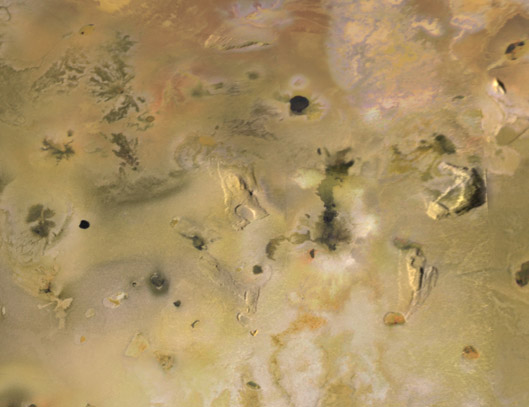 The final Io-related poster that will be presented during Tuesday's poster session at the Lunar and Planetary Sciences Conference is titled "Global Geologic Mapping of Io: Preliminary Results" by Williams et al.
The final Io-related poster that will be presented during Tuesday's poster session at the Lunar and Planetary Sciences Conference is titled "Global Geologic Mapping of Io: Preliminary Results" by Williams et al.This is an update on the author's three-year global mapping project. They are nearly finished with their work and will present a preliminary version of their global geologic map at LPSC. They hope to have a completed version submitted to the USGS by June.
Global geologic maps help scientists assess the relationships between different types of terrains as well as calculate what percentage of the surface is covered by a particular unit. For example, one project the author's plan on using the map for is to determine whether NIMS hotspots are correlated with dark lava flows, while PPR hotspots are correlated with bright lava flows. The Near-Infrared Mapping Spectrometer (NIMS) was sensitive to shorter, infrared wavelengths (1-5 microns) and thus sensed thermal emission from hotspots with temperatures greater than 200 K, often warmer than that when NIMS observed the day-side of Io. The Photopolarimeter-Radiometer (PPR) was sensitive to thermal infrared wavelengths and thus looked at cooler hotspots down to those just above the background temperature. At several locations, these hotspots were not correlated, suggesting that some PPR hotspots were related to sulfur volcanism, while NIMS hotspots were related to silicate volcanism. The authors plan to investigate that possibility.
Based on their geologic map, the authors determined that the most common surface type on Io is the plains unit, covering 66% of the surface. The next most common is the lava flow unit, covering nearly 28% of the surface.
By the way, if you want to read all of my posts covering the Io abstracts for this year's LPSC conference, you can check out the special page just for them. Still got one more to go.
Link: Global Geologic Mapping of Io: Preliminary Results [www.lpi.usra.edu]
C10 and I27 Reprocessed Images
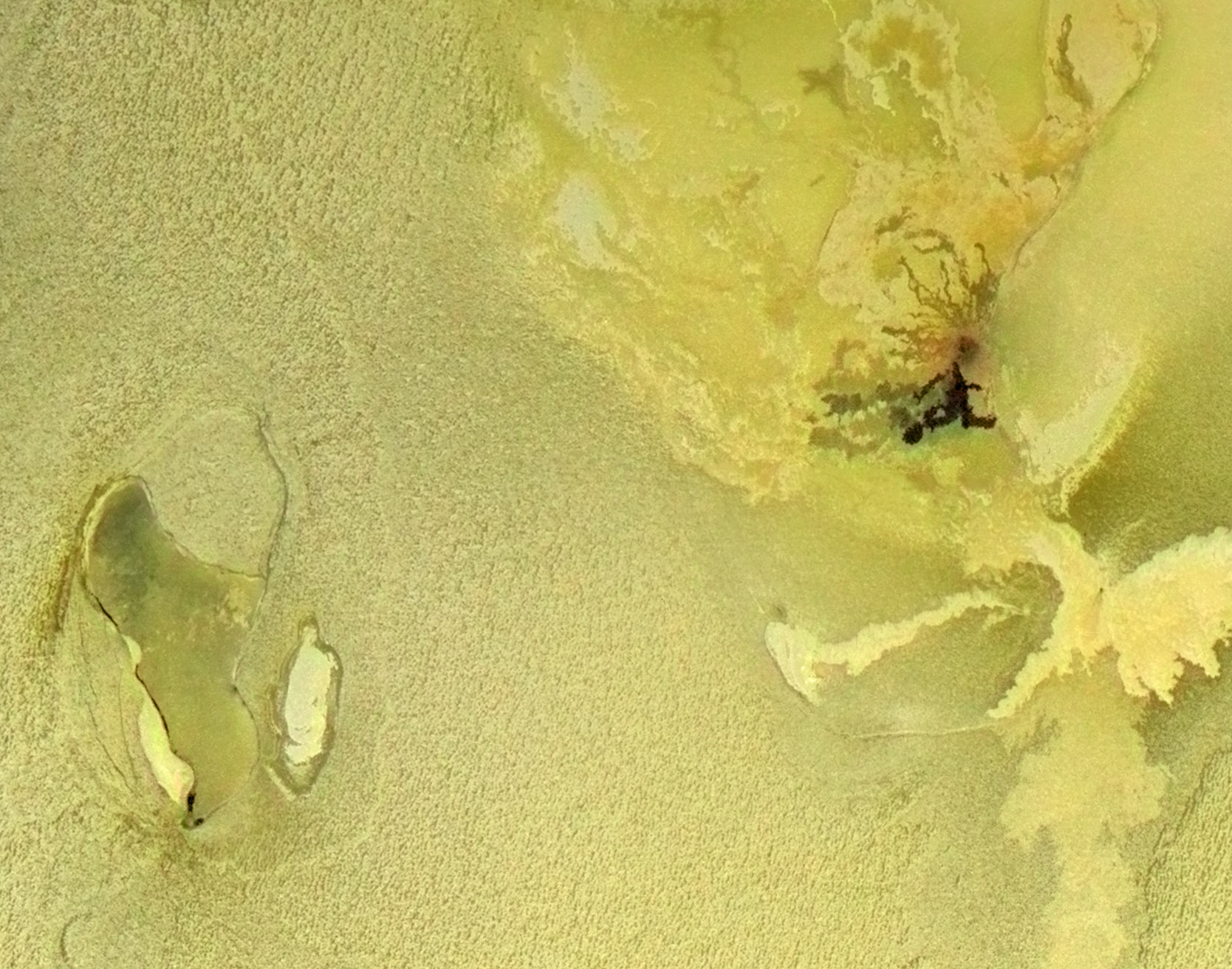 Finished up on reprocessing images from Galileo orbit C10 and worked a bit more on images from orbit I27 today.
Finished up on reprocessing images from Galileo orbit C10 and worked a bit more on images from orbit I27 today.Images from Galileo orbit C10 were acquired on September 18 and 19, 1997. Images from this encounter showed the aftereffects of eruptions at Pillan, Masubi, and West Zal during the summer of 1997. 10ISIOGLOC03 shows the trailing hemisphere of Io at 5 km/pixel. The dark pyroclastic deposits from the Pillan eruption are seen to the northwest of Pele (the volcano at the center of the ring of red material at lower left). 10ISIOGLOC01 shows the leading hemisphere. New plume deposits were seen at a volcano west of Zal Patera and at Masubi in that observation. 10ISIOTOPO02 revealed mountains and other topographic features between 60 and 90 West Longitude.
As I mentioned last night, I put together the CAMAXT01 mosaic from Galileo's February 2000 flyby of Io. This mosaic shows the region between Chaac Patera and Camaxtli Patera on Io's antijovian hemisphere at 185 m/pixel. I have now finished a version of the mosaic that combines the high-resolution clear filter data and lower resolution color data from orbit C21. Definitely worth checking out. A similar product was released shortly after the flyby. For my version, I used Moses Milazzo's "true" color version of the C21 mosaic, whereas the official version used the false color mosaic. In addition, the release version was posted before all of the fourth frame of the mosaic was returned to Earth, so this version has the entire mosaic.
Hope you all like.
Link: Galileo Images of Io [pirlwww.lpl.arizona.edu]
LPSC 2008: Io Eclipse Observations
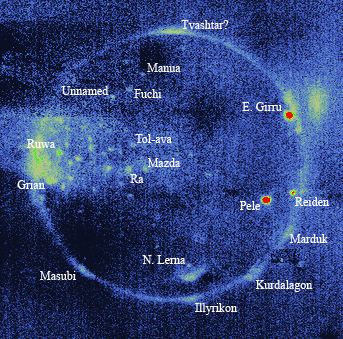 Julie Rathbun and John Spencer have a poster a this week's Lunar and Planetary Sciences Conference entitled, "Io Eclipse Observations: Does Loki Dominate Io's Infrared Flux?"
Julie Rathbun and John Spencer have a poster a this week's Lunar and Planetary Sciences Conference entitled, "Io Eclipse Observations: Does Loki Dominate Io's Infrared Flux?"Rathbun has published a few papers over the last few years on the episodic brightening experienced at Loki and what these brightenings might tell us about the Loki's eruption style. The conclusion she reached in her 2006 paper "Loki, Io: New ground-based observations and a model describing the change from periodic overturn" is that Loki Patera is a periodically overturning lava lake. According to the model presented in that paper, the surface of the Loki lava lake founders when it has cooled and thickened to the point that is negatively buoyant compared to the lava below. The time between this episodic overturning of the lava lake crust varies depending on the amount of vesicles (basically gas bubbles) within the lava crust. Essentially, the more vesicles within the lava crust, the less dense it becomes, and thus the longer it takes since the last brightening before the crust overturns again. As I mentioned in a previous blog post, Rathbun's overturning lava lake model isn't the only one published to explain Loki's behavior.
This attention focused on Loki is the result of its apparent dominance of Io's thermal flux. Rathbun and Spencer examine data taken by NASA's Infrared Telescope Facility atop Mauna Kea in Hawaii to see if Loki does in fact dominate Io's thermal flux when it is observed in eclipse. When researchers observe Io at this facility, they observe it when Io is in eclipse so they can separate flux from reflected sunlight and thermal flux from the satellite's volcanoes. If they observe Io during an occultation just as it is going behind Jupiter, or just egresses from behind Jupiter (depending on when it is in eclipse), they can measure the moon's thermal flux as it more or less of the satellite is hidden behind Jupiter. This method can help pinpoint the location of hotspots on Io's surface. Measurements were also taken of Io's full-disk while the satellite was in eclipse. Such measurements were performed at more wavelengths but their low resolution makes it difficult to pinpoint the location of individual hotspots.
Using a model Rathbun et al. developed in 2006, the authors predict Loki's brightness at 2.2 and 4.8 micron based on the volcano's brightness at 3.5 microns and the duration of the eruption episode. They determined that the 2.2 microns brightness is a close match, but they assumed that the entire thermal flux from Io at 2.2 microns came from Loki. The authors indicate that they will look at the occultation data to determine the percentage of the flux from other volcanic eruptions in order to see just how much Loki dominates Io's thermal flux.
Link: Io Eclipse Observations: Does Loki Dominate Io's Infrared Flux? [www.lpi.usra.edu]
Saturday, March 8, 2008
LPSC 2008: An Assessment of Near-Surface Conditions Conducive to Ionian Sulfur Flows
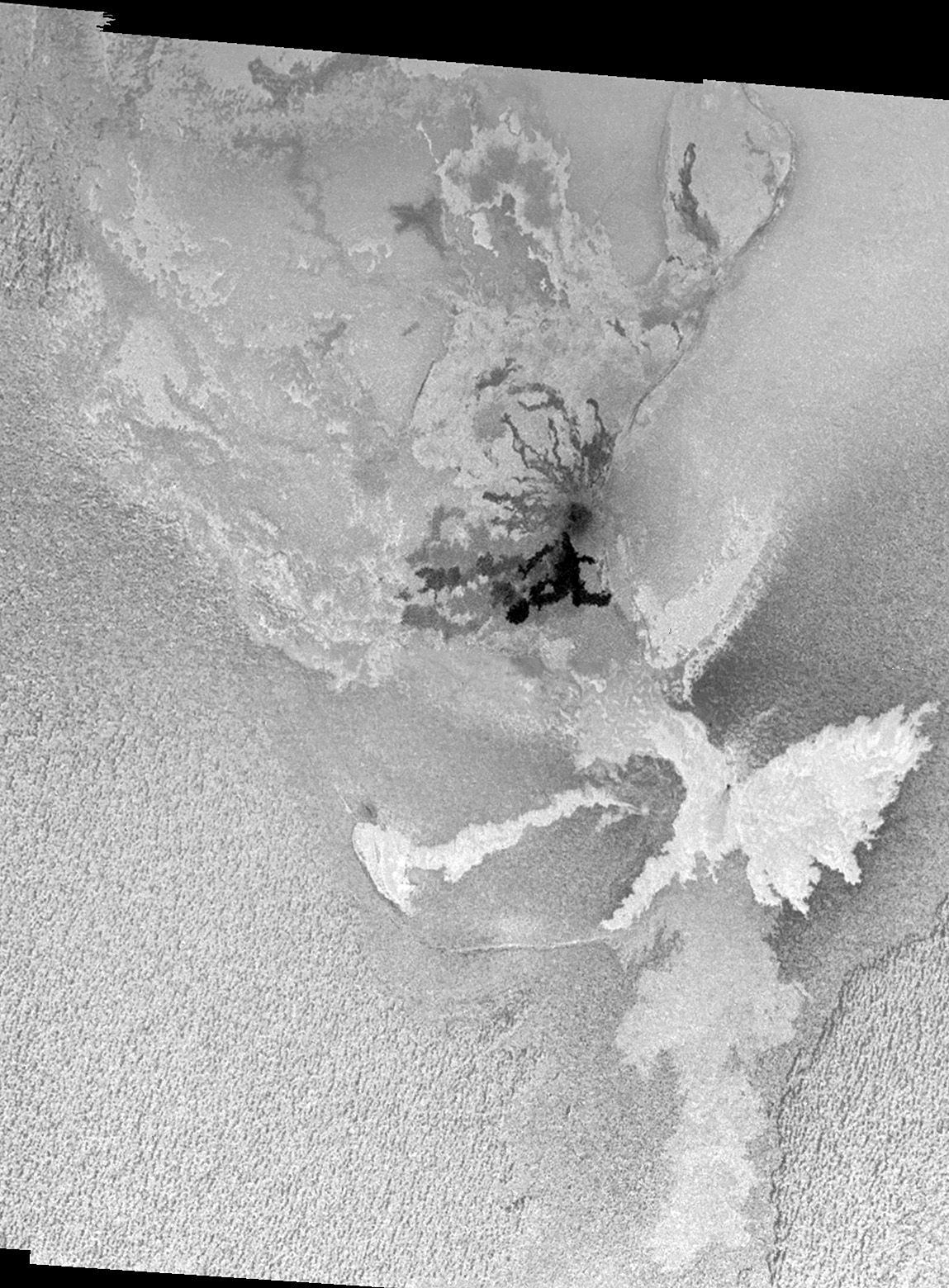 Arizona State University's Ramses Ramirez, Dave Williams, and Ron Greeley have a poster at next week's Lunar and Planetary Sciences Conference titled, "An Assessment of Near-Surface Conditions Conducive to Ionian Sulfur Flows." In this poster, the authors look at whether the bright flows seen at Sobo Fluctus (left) could have been generated secondary sulfur flows heated by a near-surface magma chamber.
Arizona State University's Ramses Ramirez, Dave Williams, and Ron Greeley have a poster at next week's Lunar and Planetary Sciences Conference titled, "An Assessment of Near-Surface Conditions Conducive to Ionian Sulfur Flows." In this poster, the authors look at whether the bright flows seen at Sobo Fluctus (left) could have been generated secondary sulfur flows heated by a near-surface magma chamber.In the model used by Ramirez et al., they consider a near-surface magma chamber whose heat is conducted by the surrounding silicate-sulfur country rock to the surface. They then estimated the amount of sulfur that would be melted by such a magma body and compared that to the size of the flows seen at Sobo Fluctus.
The authors determined that the amount of sulfur melted by a near-surface magma body was insufficient to explain the bright flows seen at Sobo. They suggest that the flows are instead primary sulfur flows, erupted from a vent with lava originating in a sulfur magma chamber below the surface.
Interesting work that further suggests the possibility of sulfur flows on Io, at least at some select locations. Many of these flows seem to occur outside of paterae. One possibility is that such activity is usually part of the first stages of paterae formation.
To create the above image of Sobo Fluctus, I reprocessed the entire CAMAXT01 mosaic from I27, which covers the region between Chaac Patera and Camaxtli Patera. Hope you all enjoy!
Link: An Assessment of Near-Surface Conditions Conducive to Ionian Sulfur Flows [www.lpi.usra.edu]
Friday, March 7, 2008
I27 Prometheus - Reprocessed (and what is that dark spot in the window?)
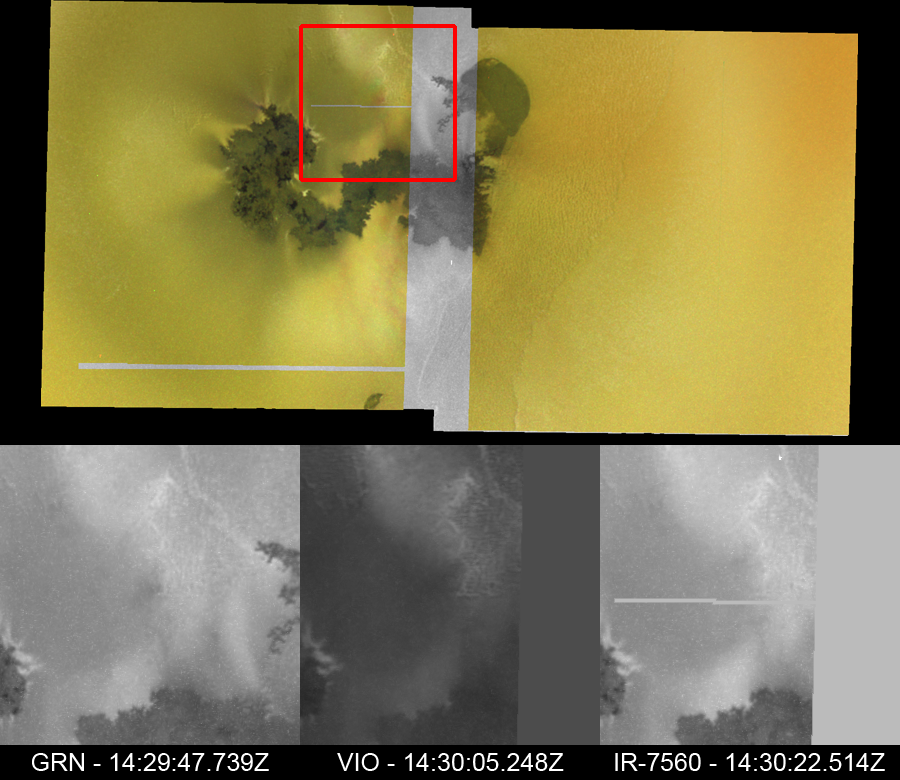 I ended up reprocessing a couple of mosaics from I27, the 27ISSAPPNG01 observation and the 27ISPROMTH02 observation. The later is one of my probably the least presented of the high-resolution Io color observations from Galileo. Most people know of the Tupan, Culann, or Tvashtar color sequences, but not this one as much. Not sure why, sure it has that strip where there is only green filter data, but it still looks very nice, IMHO.
I ended up reprocessing a couple of mosaics from I27, the 27ISSAPPNG01 observation and the 27ISPROMTH02 observation. The later is one of my probably the least presented of the high-resolution Io color observations from Galileo. Most people know of the Tupan, Culann, or Tvashtar color sequences, but not this one as much. Not sure why, sure it has that strip where there is only green filter data, but it still looks very nice, IMHO.27ISPROMTH02 shows the Prometheus volcano: its lava flows, patera, and plume deposits. The color here is a little stretched compared to natural color since it uses the near-infrared IR-7560 filter instead of red, along with the GREEN and VIOLET filters. Data from this observation was used to show how much new lava flowed out onto the surface between October 1999 and February 2000, indicating that the flow rate was 10 times greater than at Kilauea (a nice new flow from there just reached the Pacific, most news sites have cool video).
The observation also contains a rather interesting feature. There is a diffuse dark spot that moves from southeast to northwest between filters between the main patera and the western end of the Prometheus flow field. To illustrate this dark spot, I've created a little image product showing all three filter images separately and two animated gifs: one with an arrow pointing out the feature and the other without said arrow. The dark spot is near the center of each cutout. Similar moving dark features maybe seen south of the flow field. I posted on the Unmannedspaceflight.com forum about this feature last year when I first uploaded this observation on my Galileo Images of Io website. I post this again here to see what other people's thoughts are. Taking this with the possible shifting features south of the flow field, my guess is that this features is probably some kind of clump (or shadow of a clump) in Prometheus' plume. Thoughts?
Link: I27 Images [pirlwww.lpl.arizona.edu]
Thursday, March 6, 2008
LPSC 2008: Links between Volcanism and Tectonism on Io
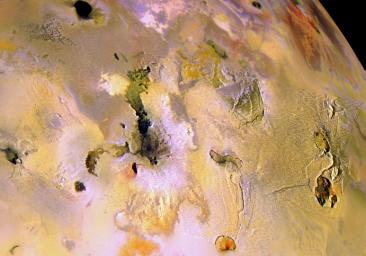 Continuing my series of posts on the Io-related posters and abstracts for next week's Lunar and Planetary Sciences Conference, we look at Giovanni Leone et al.'s poster "Links between Volcanism and Tectonism on Io: A Comparative Study of Monan Patera, Amirani, and Prometheus". In their abstract, the authors developed models for the subsurface structures underneath Monan, Amirani, and Prometheus by looking at the tectonic structures on the surface, such as mountains and fractures, and the shapes of the paterae.
Continuing my series of posts on the Io-related posters and abstracts for next week's Lunar and Planetary Sciences Conference, we look at Giovanni Leone et al.'s poster "Links between Volcanism and Tectonism on Io: A Comparative Study of Monan Patera, Amirani, and Prometheus". In their abstract, the authors developed models for the subsurface structures underneath Monan, Amirani, and Prometheus by looking at the tectonic structures on the surface, such as mountains and fractures, and the shapes of the paterae.The central thesis of their work is that the same faults that act as zones of weakness that leading to the thrusting upward of the many mountains that dot the ionian landscape are also used as conduits for magma in deep-seated reservoirs to reach the surface. They used images Galileo took of these three volcanic center to model the relationship between faults, subsurface magma reservoirs, and volcanic features on the surface.
For Prometheus, their subsurface model includes three magma reservoir: a primary reservoir in the asthenosphere, a secondary reservoir at around 17 km below the surface in the middle of the lithosphere, and a shallow reservoir between 3 and 5 km below the surface. They suggest that the three reservoirs maybe connected by a thrust fault that bounds the western margin of Prometheus Mensa, a low, lumpy mesa to the east of the Prometheus volcano, and the eastern margin of Prometheus Patera. This thrust fault was the source of the N-S lava flow seen by Voyager at Prometheus and the 75-km long lava flow that developed between Voyager and Galileo. The authors suggest, based on superposition relationships between individual lava flows in the main flow field, that this thrust fault became clogged with cooled magma and a new conduit was activated on the western side of the flow field, feeding the flows that generate the main Prometheus plume. It should be noted though that thermal emission was seen by NIMS at the thrust fault as well as the western end of the flow field, so lava is exposed at the surface in both areas (at least it was eight years ago). There is also a small plume deposit reddish material emanating from the thrust fault, suggesting that it is still active as a primary vent.
Their analysis of the images of the Amirani and Monan volcanoes suggests that those two volcanoes, as well as Maui Patera, are fed by the same magma reservoir systems. Their model suggests that branching conduits from the shallow magma reservoir underneath the Amirani vent feed Maui Patera (to the southwest of the Amirani vent) and Monan Patera (to the southeast of the Amirani vent). Diapirs in the asthenosphere imping on the base of the lithosphere cause the uplifting of nearby mountains Monan Mons and an unnamed mountain to the southwest of Maui Patera. They also suggest the presence of a cold pluton (basically a solidified magma reservoir, though the term applies to any body of magma that has solidified below the surface).
A very interesting abstract. I particularly like the discussion on the subsurface connection between different volcanoes like Amirani and Monan. Such connections can be inferred in other regions as well, particularly where nearby, normally quiescent, volcanoes erupt in a relatively short span of time. Interesting examples include the volcanoes of the Tvashtar Paterae (basically four separate volcanoes partially surrounded by two mesas) and Thor.
Link: Links between Volcanism and Tectonism on Io: A Comparative Study of Monan Patera, Amirani, and Prometheus [www.lpi.usra.edu]
Jupiter and Io animation
Welp, Io still exists as of Monday...
Mike Salway posted on the Cloudy Nights Telescope Reviews forum a nice animation created from images he acquired using his 12" Newtonian from New South Wales, Australia. Definitely worth checking out at the link below. Once at the forum thread, just click on animation.
The ALPO-Japan website has a nice image taken about 27 minutes before the start of Salway's animation by Anthony Wesley from Murrumbateman, Australia. It shows Io against Jupiter's North Tropical Zone (I think that's right, you can correct me in the comments if I am wrong).
Link: Jupiter + Io (+animation) [www.cloudynights.com]
Mike Salway posted on the Cloudy Nights Telescope Reviews forum a nice animation created from images he acquired using his 12" Newtonian from New South Wales, Australia. Definitely worth checking out at the link below. Once at the forum thread, just click on animation.
The ALPO-Japan website has a nice image taken about 27 minutes before the start of Salway's animation by Anthony Wesley from Murrumbateman, Australia. It shows Io against Jupiter's North Tropical Zone (I think that's right, you can correct me in the comments if I am wrong).
Link: Jupiter + Io (+animation) [www.cloudynights.com]
C9 Reprocessed Images
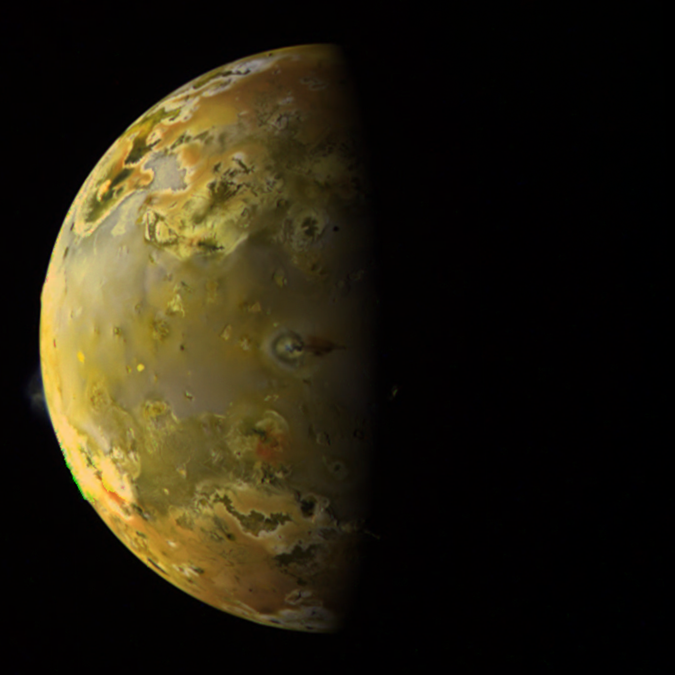 Just got done with the C9 set of images (calibrated, noise-filtered, and combined into color images). These images were acquired on June 27 and 28, 1997, more than 10.5 years ago. Each of these color images were released via the Planetary Photojournal at the time, but these images do differ a bit in term of color saturation and balance compared to the official release products. There are a couple of eclipse observations and an over-exposed Pele plume observation (that doesn't show the Pele plume, as far as I know) that I haven't processed yet. I might get to the second eclipse observation if I can figure out how to properly handle them in ISIS. I think I just have to forgo calibrating those images.
Just got done with the C9 set of images (calibrated, noise-filtered, and combined into color images). These images were acquired on June 27 and 28, 1997, more than 10.5 years ago. Each of these color images were released via the Planetary Photojournal at the time, but these images do differ a bit in term of color saturation and balance compared to the official release products. There are a couple of eclipse observations and an over-exposed Pele plume observation (that doesn't show the Pele plume, as far as I know) that I haven't processed yet. I might get to the second eclipse observation if I can figure out how to properly handle them in ISIS. I think I just have to forgo calibrating those images.Oh, I just had an idea, too late at night to see if I am right. Maybe the images remain 8-bit after calibration. Perhaps I can fix that.
Anyways, here are the three observations that I worked on this evening:
C9ISPHOTOM01 is a low-resolution, low-phase angle color sequence the leading and sub-jovian hemispheres. The image was taken to better understand the photometric properties of different surface materials. Features on Io's surface can differ drastically in appearance depending on phase angle. For example, compare Tarsus Regio, the bright region at bottom center in C9ISPHOTOM01, at this low phase angles to its appearance at moderate phase angles (like in the next image, C9ISSRFMON01). This observation was released in 1997 by the Galileo Project as PIA01220.
C9ISSRFMON01 is moderate-resolution, moderate-phase angle observation covering the leading hemisphere of Io. For this image, I merged a full-resolution clear filter image with a half-resolution, summed Red-Green-Violet color image. I also posted both separately. A similar merged product was released at the time as PIA00740. This observation was designed to look at topographic features between 30° and 65° West Longitude.
C9ISSRFMON03 is a moderate-resolution, moderate-phase angle observation covering the anti-jovian hemisphere of Io. The big discovery at the time from this observation was the plume over Pillan as part of the major eruption just north of that volcano during the summer of 1997. Hubble observations taken at the same time, IIRC, provided the first indication that something was gone at Pillan, but the plume was initially attributed to Reiden Patera, a volcano a short ways to the southeast. After the C9 eclipse observations were returned in mid- to late-July 1997, it became clear that a major eruption was occurring at Pillan. The surface changes produced by the Pillan eruption were revealed in observations acquired during the next Galileo orbit in September 1997.
Link: C9 Images [pirlwww.lpl.arizona.edu]
Tuesday, March 4, 2008
LPSC 2008: Validation of Volcanic Thermal Emission Models

JPL's Ashley Davies has published several papers over the last 11 years presenting his cooling model for terrestrial and ionian lava flows. I know this is a gross over-simplification (I'm sorry, Ashley) but basically the model inputs the near-infrared thermal spectrum of a hotspot and some appropriate physical parameters (initial eruption temperature, flow thickness, porosity, etc.), and outputs flow age, area, temperature, and flow rate (note to self: apparently I don't have his 1996 paper from Icarus on my laptop). The model has also been used to investigate eruption styles at different Ionian volcanoes.
This abstract by Davies and a cast of several covers a test on the model to see how well it reproduces the near-infrared spectrum of a lava lake on Mount Erebus on Ross Island, Antarctica. The test was needed in order to see how close to reality the model is when dealing with volcanoes on Io where we can't (at the moment) just go out and more directly measure the composition, temperature, and flow rate.
The authors imaged the Erebus lava lake (shown above) using an infrared camera and derived an integrated thermal spectrum from that data. The authors compare the model fits obtained from both one- and two-temperature fits to the Erebus data, similar to those performed by other groups on Galileo NIMS data, and from the Davies (1996) model. While the two-temperature fit modeled the lava lake well with respect to areal extent, the Davies (1996) model appears fairly robust when modeling the Erebus lava lake. One issue they do note is that in order to obtain this match, they used an eruption temperature that was 175 K warmer than what it actually is at Erebus. The authors promise further investigation on this issue and how it might affect the parameters they use for modeling Ionian lava lakes (since obviously eruption temperature is poorly constrained on Io).
Link: Validation of Volcanic Thermal Emission Models Using Ground-Truthed Data of the Erebus volcano (Antarctica) Lava Lake: Implications for Io [www.lpi.usra.edu]
Subscribe to:
Posts (Atom)









